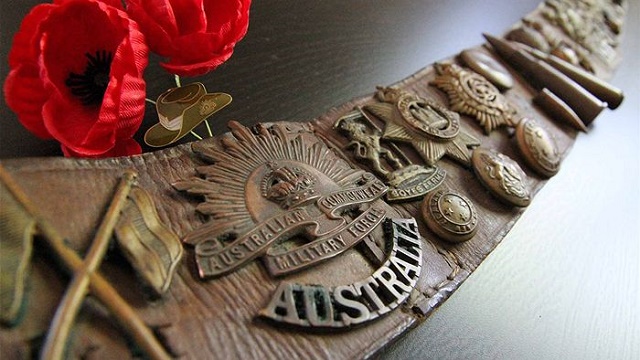A handmade belt crafted by William Percival Ross, a fighter from the 34th battalion during the First World War, shows the dedication that the man had to his fellow brothers in arms. Ross honored his comrades by adorning the accessory with several items that belonged to those with whom he fight side by side, including bullets, badges, and buttons. A truly remarkable piece, the handmade belt is just one of many such items crafted by soldiers in the trenches as a physical token of camaraderie.
Not all items are necessarily gathered from friends with whom Ross fought. Some of them were merely found strewn along the battlefields. Either way, this example of trench art—the name given to such pieces made by soldiers during less exciting moments in the trenches—shows an interesting, less violent side to the war. The handmade belt stretches about a meter in length, and is made out of thick brown leather which has been stitched together by hand. Other examples of trench art include such items used to create lighters, dishware, ashtrays, and framed photographs.
Ross had never been a soldier prior to WWI, though it did not take him long to enlist. He showed up to the fight right around the time of one of the worst winters in the war’s history, and there was a great deal of time in the trenches during which no fighting could be done. This is when he began crafting his handmade belt. While simply an artifact of interest to most, each item would have held some significance to Ross, representing those who died, those who lived, and the fields from which he gathered items dropped by those he never met, the ABC Cold and Tweed Coasts reports.
The items were collected from all over the world. Many are from allies, but not all. Whenever he was not fighting, he was able to work on attaching his collection to the length of the handmade belt, presumably never considering it to be fully complete. Due to the number of badges and buttons attained from other soldiers, it is likely that he would have traded some items of his own.
The handmade belt made by Ross may not be unique in its concept, but any such item is unique in and of itself. No other such piece of trench art could possibly showcase the exact same memories that Ross gained through his WWI experience. Now owned by Ross Eastgate, military historian and great-grandson of the man who fashioned the handmade belt, it continues to showcase the legacy of the only man who ever could have truly appreciated it to its fullest.
